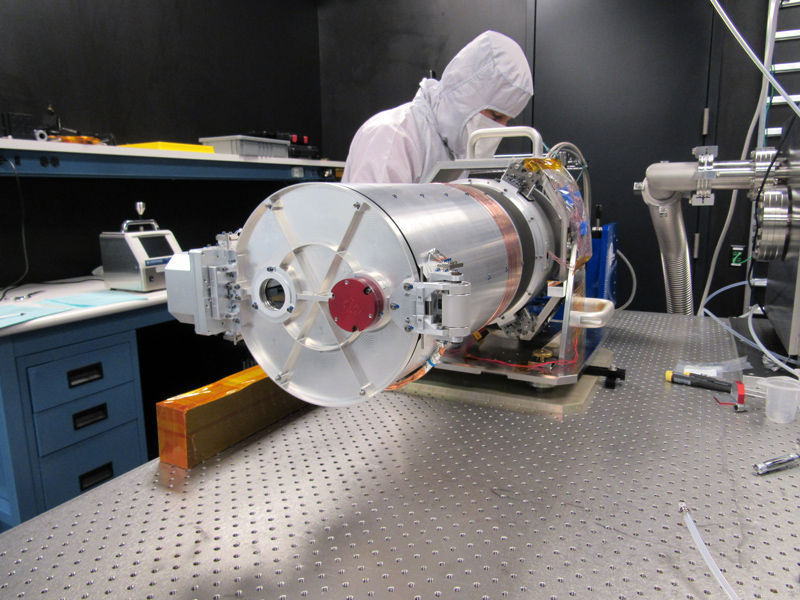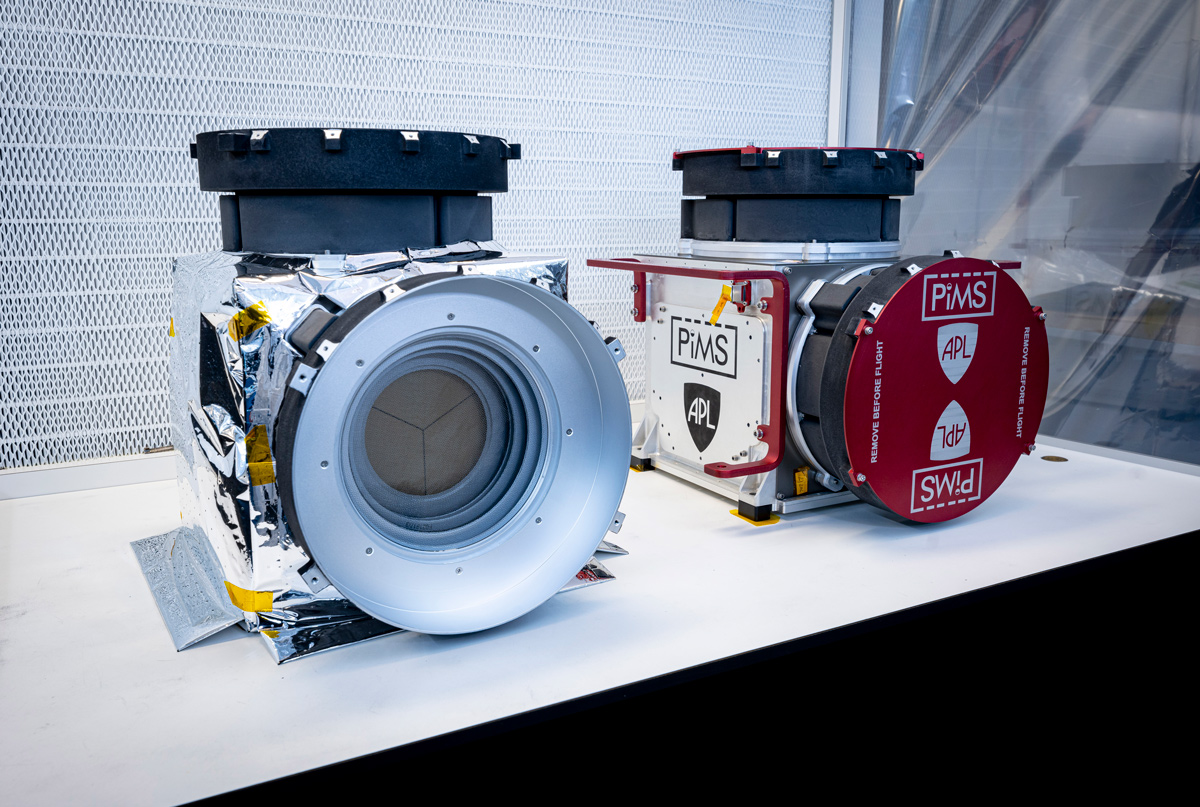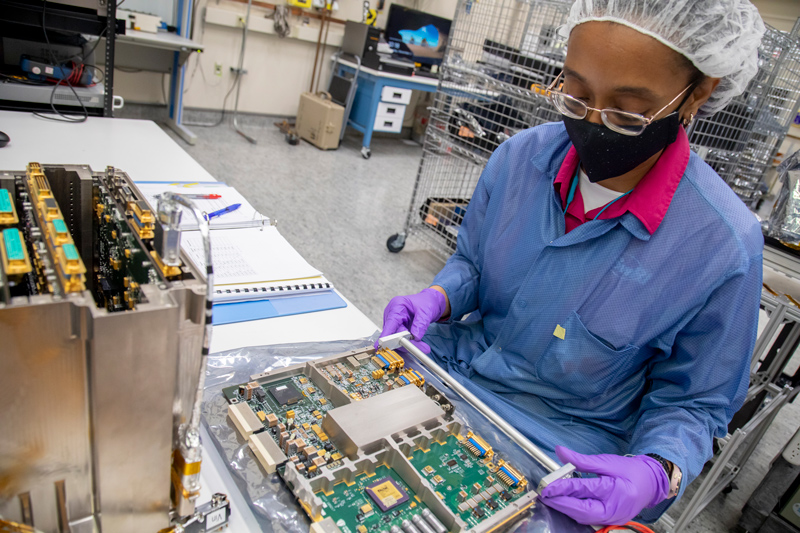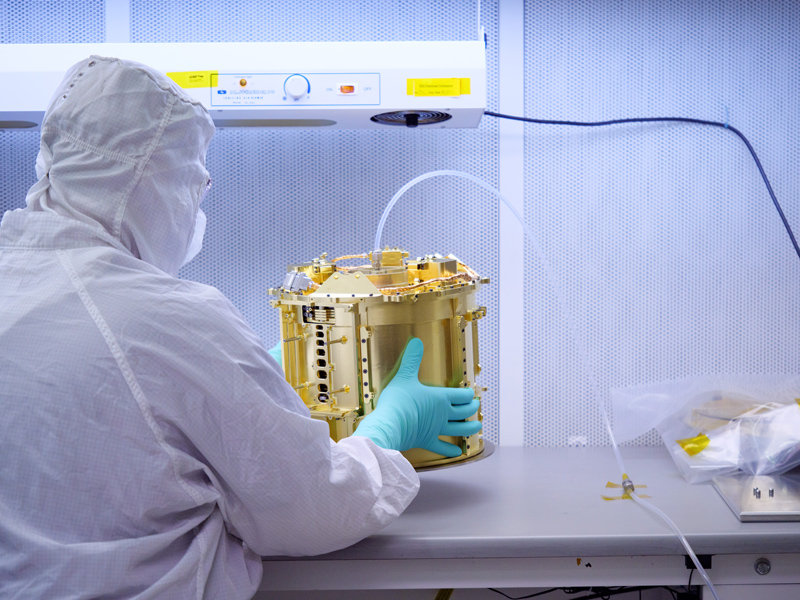What instrument collects data from places to dangerous to travel?
When Europa Clipper launches in 2024, it volition set out to respond a key question: Are there environments on Europa capable of supporting life?
To accomplish this, an intricate array of instruments will work in concert to get together measurements of the internal sea, map the surface composition and geology, and hunt for plumes of water vapor that may exist venting from the icy crust. Hither are x things to know nigh how Europa Clipper's instruments will achieve the mission's science objectives.

ane. Cameras volition produce loftier-resolution images of Europa's surface.
Europa Clipper'south imaging system will capture Europa's ridges, valleys, bands, and other surface features in unprecedented detail. The imaging system has a wide-bending camera and a narrow-bending camera. Each camera has an eight-megapixel sensor sensitive to visible wavelengths of light and a pocket-size range of virtually-infrared and ultraviolet wavelengths. The imaging system will map about 90 percent of Europa at 330 feet (100 meters) per pixel. That's 6 times more than of Europa'southward surface than was mapped by images from the Galileo spacecraft, the Jupiter orbiter that captured images of Europa in the late 1990s.
2. Infrared low-cal reflected from Europa will be analyzed to determine the moon's surface composition.
Europa Clipper will also determine the moon's surface limerick. The mission's imaging spectrometer will clarify infrared lite reflected from Europa to wait for organics, such every bit sulfates and carbonates, and other compounds. The instrument volition measure the presence, absenteeism, and force of various wavelengths of light that help scientists infer composition. The imaging spectrometer volition map Europa's surface composition in item, helping scientists understand Europa'south geologic history and the moon'south suspected ocean.
iii. An ice-penetrating radar will search for subsurface lakes similar to those beneath Antarctica'due south ice canvass, and produce 3D images of Europa'due south ice shell.
One of Europa Clipper's instruments will use radar to penetrate the moon's icy shell, searching for the suspected body of water beneath and studying the ice'south structure and thickness. The water ice-penetrating radar will transmit radio waves that bounce off features within the subsurface ice.
4. A magnetometer will measure the strength and direction of Europa'south magnetic field…
The mission will also carry a magnetometer to measure the strength and direction of the moon's magnetic field. Europa doesn't independently generate its ain magnetic field. Just time-variations of Jupiter's magnetic field induce a magnetic field within Europa, presumably via electric currents flowing in a salty ocean beneath Europa's ice. On a boom 25 feet (8.5 meters) in length when fully deployed, Europa Clipper's magnetometer instrument volition measure the forcefulness and orientation of both Europa and Jupiter's magnetic fields during dozens of Europa flybys. The instrument will permit scientists to measure the depth and salinity of Europa's suspected ocean as well every bit the ice trounce'south thickness.

5. …and a plasma instrument volition study the flow of plasma nigh Europa, helping to calibrate data from the magnetometer.
Jupiter's magnetic field besides carries charged particles in an ionized gas called plasma from the volcanic moon Io, Jupiter's ionosphere, and Europa itself. This plasma distorts Europa'due south induced magnetic field. The mission's plasma instrument volition report the density, temperature, and flow of plasma near Europa. The plasma instrument has four sensors called Faraday cups, which are metal cups designed to catch charged particles in space. Plasma creates an electrical electric current when information technology strikes a detector plate located within a Faraday loving cup, revealing the plasma'due south speed and density. While interesting on its ain, understanding the density, temperature, and flow of plasma will help calibrate data from the spacecraft's magnetometer. The powerful combination of these ii instruments is fundamental to precisely determining Europa's ice shell thickness, and the depth and conductivity of its bounding main.
6. Gravity experiments will also help decide the thickness of Europa's water ice beat out.
Finding out the thickness of Europa's water ice shell is important for understanding whether places be below the moon's surface that could support life today. Thinner ice or h2o passing through the ice would assist essential chemical building blocks on Europa'southward surface reach the ocean, improving the odds that the moon could sustain life. While the spacecraft'southward ice-penetrating radar and magnetometer will provide complementary means of measuring the ice shell'southward thickness, gravity experiments volition as well allow scientists to get detailed measurements of the varying shape of Europa's surface as it orbits Jupiter besides as detailed information near Europa's subsurface.
7. A thermal instrument will survey Europa'south frozen surface in search of recent eruptions of warmer water at or near the surface.
Europa Clipper will carry a thermal emission imaging system that will analyze infrared light from Europa to map the temperatures across the moon's surface. It volition seek clues well-nigh activeness, such as cryovolcanoes and regions where the moon'due south suspected ocean may be near the surface. When function of Europa rotates out of sunlight, granular material cools faster than big blocks of fabric. The thermal imaging system will record surface cooling rates to learn about the texture of Europa's surface. Mapping surface temperature and h2o near the surface will assistance to empathise Europa's small-scale properties.
eight. An ultraviolet spectrograph will search for potential plumes of h2o vapor, and provide data on the moon's surface and thin atmosphere.
By collecting ultraviolet light with a telescope and creating images, Europa Clipper's ultraviolet spectrograph will search for potential plumes of h2o vapor that might erupt from Europa'southward surface, in add-on to providing data about the composition and dynamics of the moon'south sparse atmosphere, and data about the composition of the moon's surface. The instrument collects ultraviolet light and separates its wavelengths with an optical grating. The ultraviolet spectrograph will primarily identify relatively simple molecules, such as hydrogen, oxygen, hydroxide, and carbon dioxide.

9. A mass spectrometer will collect and reveal the molecular identities of gases in Europa'due south faint atmosphere and from possible plumes.
In addition, the mission'due south mass spectrometer will identify and analyze gases in Europa's faint atmosphere and from possible plumes. The mass spectrometer volition collect gases, convert them into charged particles called ions, and bounce the ions back and along within the musical instrument. By timing their transit through the instrument, the mass spectrometer determines the ions' masses, thus revealing their molecular identities. It volition report the chemical science of the moon's suspected subsurface ocean, if and how the ocean and surface exchange fabric, and how radiation alters compounds on the moon's surface

10. A dust analyzer volition scoop up larger particles and place their chemistry.
Tiny meteorites eject bits of Europa's surface into space and a subsurface bounding main or in-water ice water reservoirs might vent material into space as plumes. To study this, Europa Clipper'south grit analyzer will scoop upward larger particles from these plumes and identify their chemical science, revealing Europa's surface composition including potential organic molecules. The dust analyzer tin notice salts in the dust and ice grains, providing additional information about a subsurface sea. If a subsurface ocean or reservoir is venting fabric into space as plumes, the grit analyzer volition assist united states to determine if Europa's water is suitable for some form of life.
Explore the Spacecraft
NASA's Europa Clipper spacecraft will conduct a detailed survey of Jupiter's moon Europa to determine whether the icy moon could harbor weather condition suitable for life. Europa Clipper will comport an advanced suite of science instruments to notice whether Europa hosts environments suitable for life.
Explore an interactive model of the spacecraft ›
Source: https://europa.nasa.gov/news/41/10-things-to-know-about-europa-clippers-science-instruments/
Post a Comment for "What instrument collects data from places to dangerous to travel?"